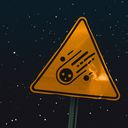The asteroid threat gets real

Scientists say it's time to take the threats posed by asteroids seriously and prepare for the possibility that one could be found on a collision course with Earth.
Why it matters: Asteroid strikes are rare, but the danger posed by even a relatively small one impacting Earth over a populated area could be serious, and it might be harder to spot these hazardous space rocks in the future.
- Scientists are keeping tabs on thousands of asteroids with orbits known to bring them close to Earth's path around the Sun, but they still don't have the tools they need to find all of the possibly dangerous asteroids nearby.
- "An asteroid impact is very similar in structure to a pandemic," Casey Dreier of the Planetary Society tells Axios. With both events, it costs more to respond to them if a society isn't prepared.
Driving the news: NASA slammed a spacecraft into an asteroid on Monday in a bid to change its orbit and test the technology needed to one day redirect an asteroid found on a collision course with Earth.
- It's not yet clear whether the impact changed the course of the moonlet asteroid circling a larger asteroid, but follow-up observations over the coming weeks will reveal how successful the test was.
- If a large asteroid is one day found to threaten our planet, NASA says the data gathered by this mission — called the Double Asteroid Redirection Test — should help them to scale up the tech to throw that space rock off course.
- "We also have to understand the nature of these objects, what their sizes and compositions are and their orbital path to determine when in the future they might pose a hazard," NASA planetary defense officer Lindley Johnson said during a press conference last week.
How it works: Scientists use a variety of telescopes to discover asteroids and other near-Earth objects (NEOs) and then track their orbits around the Sun.
- Ground-based telescopes like Pan-STARRS take wide images of the sky to pick out the faint signals of asteroids as they move through space.
- But "less than half of the estimated 25,000 NEOs that are 140 meters and larger in size have been found to date," according to NASA.
The intrigue: In 2021, NASA formally moved ahead with the NEO Surveyor telescope — which is specifically designed to search for difficult-to-find asteroids from space using infrared light — and the telescope won bipartisan political support, with a plan to launch by 2026.
- But this year, the proposed budget for the program was cut by $130 million, delaying the launch by two years.
- Even though Congress is pushing to restore some of the funding, the budget cut has already caused layoffs on the mission team and is forcing them to replan the development of the telescope.
Between the lines: NASA has not given a public explanation for why NEO Surveyor's budget was cut.
- According to Johnson, a delay of two years likely won't mean scientists miss a dangerous asteroid on its way to Earth, but launching NEO Surveyor is "something that we need to get done so that we know what's out there and know what's coming and have adequate time to prepare for it."
- "We can't really do anything about a potentially dangerous object heading our way unless we know it's there," Amy Mainzer, the head of the NEO Surveyor mission, tells Axios.
What to watch: NEO Surveyor may be even more essential in the coming years as constellations of satellites continue to clutter Earth's orbit.
- Scientists are concerned that as companies like SpaceX and OneWeb continue to send hundreds of satellites to orbit, the light from satellites at dusk could make it harder to find certain dangerous asteroids near our planet.